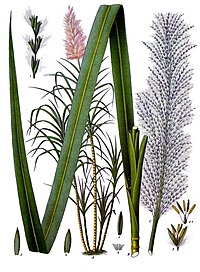
Photo from wikipedia
Abstract Open burning of sugarcane (Saccharum officinarum) has a large impact in regional atmospheric pollution and global climatic change. In this research, pollutant emissions from sugarcane residues burning were measured… Click to show full abstract
Abstract Open burning of sugarcane (Saccharum officinarum) has a large impact in regional atmospheric pollution and global climatic change. In this research, pollutant emissions from sugarcane residues burning were measured in order to determine the emission factors (EFs) of elemental carbon (EC), organic carbon (OC), 18 polycyclic aromatic hydrocarbons (PAHs), K, Na, Ca, Mg, NO3−, SO42−, NH4+, and Cl− contained in particulate matter (PM), as well as EFs of the gaseous pollutants, carbon dioxide (CO2), carbon monoxide (CO), methane (CH4) and 37 volatile organic compounds (VOCs). Experiments were carried out in an open combustion chamber equipped with isokinetic sampling, following EPA 5 and modified EPA 201-A methods. Preliminary tests showed that continuous feeding of residues does not represent the open burning carried out in the field since flaming stage is sustained, thus batch feeding of residues was used to perform around 30 experiments. Gaseous pollutants EFs were 1618 ± 108, 25.7 ± 2.04 and 2.29 ± 0.13 g kg−1 for CO2, CO and CH4 respectively, while C2 compounds have the highest EF of VOCs. PM10 and PM2.5 accounted for 55% and 36% of total PM mass, whereas carbonaceous species (EC and OC) accounted for 66% in PM2.5 and 58% in PM10 and total PM mass. Emission factors of EC varied from 0.34 to 0.37 g kg−1, and EF of OC were 0.44, 0.67 and 1.2 g kg−1 for PM2.5, PM10 and total PM, respectively. Highest EFs of determined elements and anions were K and Cl−, respectively. Heavy PAHs such as benzo[b]fluoranthene, bezo[k]fluranthene and benzo[a]pyrene presented the greatest EFs with 0.265 ± 0.04, 0.264 ± 0.08 and 0.254 ± 0.015 mg kg−1 respectively. Kruskal Wallis tests indicated that EFs had no significant differences among sugarcane varieties harvested in sites with different altitudes and climate, thus they can be applied for inventories estimations in world regions similar to Mexico, as well as in air quality forecasting models and climatic model allowing a better knowledge of air pollution and climatic change scenarios. The results of this research can be the base to design and establish public policies in order to regulate and eventually eliminate the practices of pre-harvest and post-harvest sugarcane burning.
Journal Title: Atmospheric Environment
Year Published: 2018
Link to full text (if available)
Share on Social Media: Sign Up to like & get
recommendations!